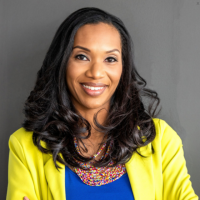BELIEVE works to improve Black maternal health
November 21, 2022
From Nicole Moorefield, The Well
According to the most recent WHO/UNICEF data, the United States maternal mortality rate in 2017 was 19, the rate being the number of maternal deaths per 100,000 live births. Not only is that much higher than the maternal mortality rate of similarly developed countries — Italy (2), Ireland (5), Australia (6), Germany and the United Kingdom (each 7) and France (8) — but the numbers also show stark racial inequity. While the maternal mortality rate for non-Hispanic white patients is 14.9 and for Hispanic patients 11.8, for non-Hispanic Black patients, the rate is 37.3.
One way doctors and researchers at Carolina are trying to address the problem of Black maternal mortality — and Black maternal health in general — is through a new project called Building Equitable Linkages with Interprofessional Education Valuing Everyone.
BELIEVE, a collaboration between Carolina and North Carolina Agricultural and Technical State University, aims to improve maternal care teams and overcome health care disparities.

Kimberly Harper

Janiya Williams
The program is the brainchild of Kimberly D. Harper, perinatal/neonatal outreach coordinator with the School of Medicine’s Center for Maternal and Infant Health, and Janiya Williams, program director and clinical instructor at North Carolina Agricultural and Technical State University (NC A&T)’s SU Pathway 2 Human Lactation Training Program.
Alison Stuebe, MD, professor of obstetrics and gynecology at the School of Medicine and professor of maternal and child health at the UNC Gillings School of Global Public Health, joined the team to help secure the necessary funding to get the program off the ground. In July 2022, BELIEVE received a $2.4 million grant from the American Heart Association to develop a curriculum that cultivates trust among patients and health team members.
Harper’s background is as a labor and delivery nurse. Williams pivoted from a career as a speech therapist to working as a lactation consultant.
Having seen in their previous work how many different people beyond clinicians interact with families in birthing and raising children, Harper and Williams wanted to focus on strengthening the birthing team, including lactation consultants and doulas.
Take something as natural as lactation. “People who look like me weren’t doing it, and there was a lack of support in that area,” Williams said.
For years, the Black breastfeeding rate has been lower — and the infant and maternal mortality rates higher — than in white birthing people, she said.
“After I had my own child, I noticed that people around me weren’t breastfeeding, and I wanted to make sure that the importance of giving our babies human milk was brought to the forefront,” Williams said. “We know that if we give human milk at the very beginning, that sets folks up for a better life — because breastfeeding affects everything.”
And despite their intrinsic value as a support system for patients throughout the entire birth experience, doulas and other birthing team members are often underappreciated.

Dr. Alison Stuebe
“There’s data for decades showing that having labor support from a doula or continuous health worker for the mom improves outcomes,” Stuebe said. “But I also know as an obstetrician that doulas are sometimes viewed with some eye-rolling by obstetric providers.”
Harper said there is a benefit to the entire care team coming together, out of their own silos of expertise, and making sure the patient is well cared for by everyone, regardless of role.
“In order to deliver care that takes on this enormous environment, it’s not just the doctor telling the patient to do something,” Stuebe said. “It’s the doctor, the nurse, the social worker, the doula, the community health worker, the outreach worker, the public health person — and if they don’t play well together, then they’re not going to be able to support the mom who’s at the center.”
Harper said it is important to not focus singularly on maternal mortality — those who lose their lives — but also to highlight morbidity, those who endure trauma or need additional support due to their experiences during pregnancy.
Additionally, maternal health affects the entire family, Harper said. Often, mothers choose the physicians their family members will see, and if they have a traumatic experience with a certain provider, that will impact where they go in the future.
“Our work is important because so often our voices are silent, especially as people who identify as Black women, and we’re often not heard by our health care providers,” Williams said.
Part of the beauty of BELIEVE is innovation, Stuebe said. “We’re going to start out by listening to folks with lived experience, so we’re going to engage families. We’re also going to engage members of the health team to talk about, ‘What does it look like when the team is all playing together, and what does it look like when everybody is trying to score points without considering the team as a whole?’”
From there, they will build an education curriculum and provide a low-risk, virtual environment for students across varying medical fields to practice those skills. They will have actors as patients playing out various scenarios that a care team will treat together. Afterward, they will debrief and talk about what went well, what went wrong and how they can make the experience better for the patient.
“By working together, we’re going to assist with establishing trust within the health care system,” Williams said.
‘Not one-size-fits-all’
Pregnancy is an especially important time to address institutional inequities, Stuebe said, because it is many patients’ first substantive experience with health care as an adult.
“If that experience is positive, if they feel seen and heard and valued, then that will affect how they engage with their child’s provider, with their own health care and with their entire social network,” Stuebe said.
Williams referenced what she calls “the mirror effect”: When people of color receive messages about health care from other people of color, especially when their providers are also people of color, they are less apprehensive and more likely to listen.
“It’s one less thing that they have to explain when they walk into the room,” Williams said. “It’s kind of, ‘I see you. I’m going to hear you. I’m going to value what it is that you’re saying to me and make a patient recommendation instead of just using cookie-cutter plans.’ Because health care is not one-size-fits-all.”
A 2021 study showed that Black babies attended to after birth by Black doctors had their mortality rate cut in half. While the same study did not find a correlation between Black pregnant people and their care teams, Williams and Harper agreed that shared experience can be beneficial in trusting a health care provider.
But Harper said that even seeing a provider of color doesn’t take you out of a health care system that has barriers that need to be changed.
The system
For decades, the medical profession has seen gaps in pregnancy outcomes between white patients and patients of color, Stuebe said. But despite past efforts to pin those disparities on racial differences, the real culprit is long-established systemic inequities that negatively affect people of color.
Among the examples Stuebe cites is redlining, the practice of refusing loans to residents of certain areas along racial lines.
“You can map health disparities today to redlining maps from 100 years ago,” Stuebe said. “Folks who live in neighborhoods where community wealth could not accrue because of very deliberate social policies have worse health in the present day.”
Additionally, Stuebe said that cumulative exposure to racism can cause health problems, and a lack of resources can play into that.
“It is harder to eat healthy foods if you live in a food desert. It’s hard to get exercise if there are no sidewalks,” Stuebe said. “All these kinds of things that are stacked against particular communities have led to higher rates of diabetes and hypertension, both of which are risk factors for problems during pregnancy.”
Pre-term birth is also more common in Black patients than in white patients, Stuebe said.
Stuebe referenced a quote from Black Women Birthing Justice, a California-based collective: “There is no answer to solving this crisis that Black women do not already know. It is in their lived experiences and resilience that drives innovation and belonging — and we as stakeholders should take heed.”
Williams said that she appreciates the collaboration between Carolina, a predominantly white institution, and NC A&T, a historically Black university.
“So often there’s a group of people at the table with funding that are looking to just check boxes off,” she said. “This is more than that, because Alison actually gave Kimberly and me the steering wheel to mold and shape this project to how we believe it should go. For HBCUs to be involved, it gives us a voice at the table so it’s not just, ‘Oh, this is how we’re going to save all the Black women and all the Black babies today,’ and not invite anyone who looks like Kimberly and myself to the table.”
